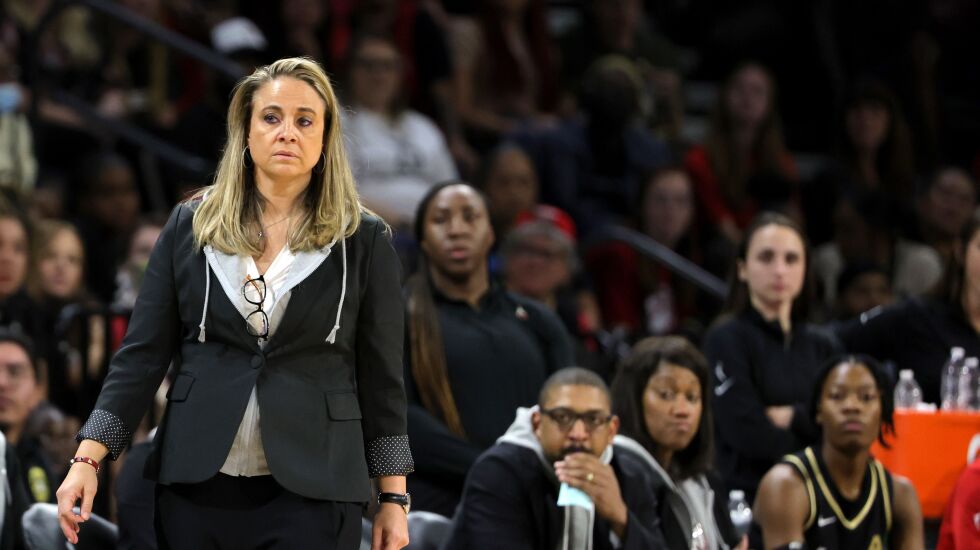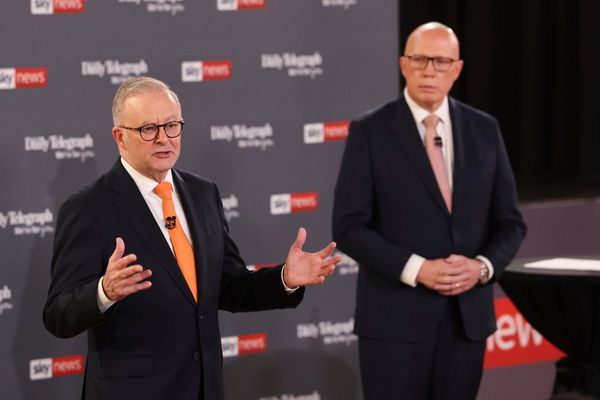
LOS ANGELES — Before her team’s 104-95 loss Tuesday to the Sky, Las Vegas Aces coach Becky Hammon fielded questions from media about A’ja Wilson’s dominance this season, expectations she had for herself and her team coming into the job in 2022, and the type of team the Aces have turned out to be.
Her responses were detailed but light. Hammon had an ease about her, even letting out a couple of laughs as she spoke.
As the moment for Hammon to return to game prep inched closer, one final question was asked: “What are your thoughts on how Title IX has progressed over the [last 50] years?”
Hammon responded with the same ease as before but with a slightly more direct tone.
“Obviously, I’m a product of Title IX,” she said. “My whole life, my whole livelihood was because Title IX was in place.”
In December, Hammon was hired as the Aces’ coach, and the job offer came with a seven-figure contract, making her the highest-paid coach in the WNBA.
Hammon’s illustrious professional career followed by her eight years as an assistant coach on Gregg Popovich’s Spurs staff is the kind of career trajectory that used to be associated solely with men. But thanks to Title IX, things have changed, and Hammon is a role model for people everywhere.
But what about the women who didn’t go on to become the highest-paid coach in the WNBA? The impact of Title IX extends far beyond the professional sports landscape, making the need for it to be solidified all the more crucial.
A USA Today investigation found that 87% of colleges and universities still are not providing opportunities proportionate to the number of women enrolled in their schools. Their research found that Northwestern would need to add 27 roster spots for women to close the participation gap, and the University of Illinois would need to add seven.
The U.S. Department of Education has a three-prong test to assess Title IX violations: proportionality, expansion and interest. If schools can’t show proportionality within their programs they must prove they are working to expand opportunities for women. If they are unable to meet those two criteria they must show they are accommodating the interests of their students.
Fifty years later, there is a reluctance to discuss compliance for certain athletic departments. Northwestern athletic director Derrick Gragg was not available for an interview. The university’s deputy athletic director, Janna Blais, politely declined to speak with the Sun-Times.
When asked about Title IX, conference leaders often are quoted sharing iterations of the same thought, namely that more work needs to be done.
“We have an emerging sport in women’s volleyball,” said the Big Ten’s deputy commissioner and chief sports officer Diana Sabau. “It’s hugely popular and hugely successful, so we decided we were going to have a women’s volleyball media day. [We were] the first conference to do a women’s volleyball media day. [To shape the next 50 years of Title IX], it’s looking at what’s relevant, what is tangible, what we can do to take the profile of a woman’s sport and bring it even higher in society at the moment.”
A report released by the NCAA on Thursday morning titled “The State of Women in College Sports” detailed progress for women and girls in sports, and areas that need improvement. In 2020, 47.1% of participation opportunities were for women across Division I athletics compared to 26.4% in 1982. Startling though, was the resources allocated to men’s athletics compared to women’s.
Title IX does not require equal spending for men’s and women’s programs, rather its focus is on resources being spent to provide equitable treatment. According to 2018-19 NCAA Financial Reporting System data, men’s Division I programs’ total expenses receive 44% of spending funds compared to the 21% for women. In recruiting, that gap is even higher with men receiving 71% of funds compared to 28% for women. Scholarship allocation is the closest to being equal, with men receiving 52% of expenditures and women receiving 45%.
The data also accounted for unallocated/coed funds that are not related to any specific team, such as fundraising and facilities used by both men’s and women’s programs.
One of the clearest examples of how inequitable treatment can impact women’s opportunities is NIL.
According to Opendorse, a company that provides technology to the athlete-endorsement industry, through May 31, football was the top sport for NIL compensation (49.9%), followed by men’s basketball (17.0%) and women’s basketball (15.7%). Women’s volleyball is fourth receiving 2.3% of NIL compensation.
As the 50th anniversary of Title IX is celebrated by athletic departments, leaders and athletes, it’s critical that the extensive gaps between men and women are discussed. Pioneers of Title IX such as Hammon are happy with the progress but won’t be satisfied until true equality is reached.
“We have to continue to push that line and as a latter stage of opportunity has to come equality,” Hammon said. “For me, it’s still about kids and young girls getting involved. It’s also about the perception of the next generation seeing women and girls are great athletes, period, you leave it there.”







